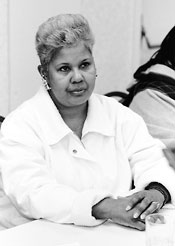|
CalWorkS December 2000 by Richard Bermack California is developing another computer program, this time for eligibility work. Have they learned from the disasterous CWS/CMS debacle? Will they take the advice of workers into consideration in building the system? Will the new system be used to assist workers in providing comprehensive services to clients, or will it be used to speed up work and further dehumanize the welfare system? The counties in the CalWIN-WCDS
consortium are presently using the Welfare Case Data System (WCDS),
which will be replaced by the CalWIN computer system. The name CalWIN
is presumably derived from CalWORKS and WIN, which is an acronym for the
generic term Welfare Information Networks. The CalWIN system is in the
early developmental stage.
According to Alameda County eligibility worker Darlene White, under WCDS, potential TANF (Temporary Assistance to Needy Families) recipients in Alameda County attend group orientation meetings where they fill out a form listing their income, assets, and other pertinent eligibility information. Each applicant then meets with a worker who reviews the information and determines which programs the client is eligible for and calculates the amount of benefits the client is entitled to receive. After manually making these computations, the worker enters the information into the WCDS computer program. WCDS then transfers the data to the appropriate computer system for that benefit program. Each benefit program has its own system, and they read like an alphabet: FAIR (Food Stamp Automated Issuance Reporting System), MEDS (Medical Eligibility Data System), IEVS (Income and Eligibility Verification System), and SAVE (Systematic Alien Verification System for Entitlement ). The component system processes the information and sends a letter to the client, with a copy to the worker, listing all the particulars of the case and how much the client is entitled to receive. The case history is stored in WCDS, but the component system determines the client’s monthly benefits. Information flows from WCDS to the component systems, but only in one direction, so the worker must update the WCDS computer manually to indicate things such as how many checks the client has received. The client must see different workers for each benefit program, and information is stored by cases, not clients, so there is a different case file for each program. The on-line information is not well linked. CalWIN has the potential to clean up this mess. All the computer systems would be integrated into one system. The plan is for a worker to enter information into the computer live, while interviewing the applicant. Interactive computer screens would guide the worker through the interview process, and data would be entered in real time. The computer would then analyze the data and determine eligibility not only for TANF, but for all the other benefit programs as well, such as MediCal, food stamps, foster care benefits, general assistance, employment services, etc.
|
|||||||

